Poor Luigi. Mario’s lanky counterpart is most often defined not by his own merits, but by his proximity to his elder brother. Even in 2013, a year that Nintendo has branded “The Year of Luigi,” the green plumber is more punchline than protagonist, complete with Chaplinesque antics and a tendency to cower behind Mario during times of crisis.
In Mario & Luigi: Dream Team, which comes out August 11 for the 3DS, Luigi isn’t even awake half the time. You, as Mario, will spend a solid 40-50% of the game exploring various dream worlds created by placing Luigi on pillows and entering the portals he creates while snoozing. Within those portals, the rules of physics work a little bit differently. They mostly require you to abuse the hell out of Mario’s younger brother, yanking his mustache and prodding his nose in order to solve the puzzles inside of his imagination.
I really do feel bad for Luigi. Bowser doesn’t even know his name.
OK, let’s reset for a second: you are entering Luigi’s dreams because you have to rescue Princess Peach — of course — who was kidnapped — of course — while you all were vacationing on Pi’illo Island. This island, you learn early in the game, was once inhabited by a race of pillow-like creatures called the Pi’illo, who were all put to sleep by a demonic bat creature and are now trapped within the dream world that Luigi can help you access. You’ve gotta rescue them, and the princess — of course.
So you’ll adventure through this dream world quite a bit — more times than you might expect — both for quick naps and drawn-out snoozes. Those somnolent moments can sometimes drag down Dream Team, a long role-playing game that is otherwise stellar, securing the rank of My Favourite Mario & Luigi RPG. (I can’t decide if I like it more than Paper Mario: The Thousand Year Door or Super Mario RPG, but it’s on that level.)
Mario & Luigi: Dream Team is a wonderful, charming, funny game that you must play if you own a 3DS and like RPGs, or don’t normally like RPGs but feel compelled by the idea of one starring Mario. Full of whimsical chatter and overwhelming tutorials, the game will challenge your thumbs far more than your brain, and it remains appealing even during those moments when you might feel like you’re just going through the motions.
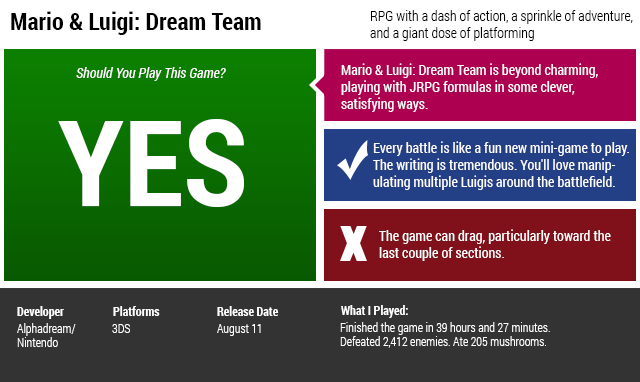
Like other Mario & Luigis, Dream Team gives you control of the two plumbers both in combat and in the field. While exploring the real world, you’ll gradually get new abilities that you can use to interact with the environment, Zelda-style. Get a hammer and you can make Luigi whack Mario over the head, for example, shrinking the red guy and allowing him to duck under passages that’d otherwise be inaccessible. As you progress through the game, you’ll learn new abilities, and more areas of Pi’illo Island will open up to you. They’re all quite lovely.
Really, the whole game looks great. It took the folks at AlphaDream some four years to make Mario & Luigi: Dream Team, and that time was well-spent — everything is shiny and polished and intricate. For comparison, here’s a screenshot from the 2009 Mario & Luigi: Bowser’s Inside Story:
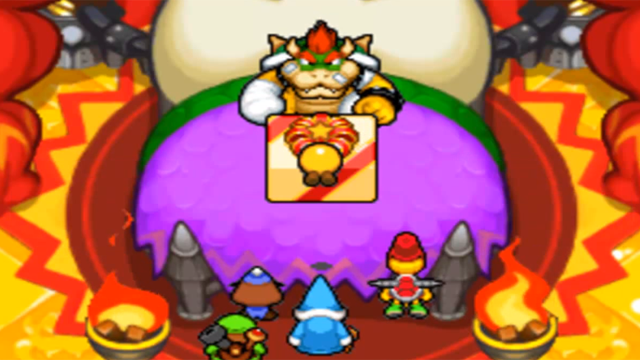
And here’s Dream Team:
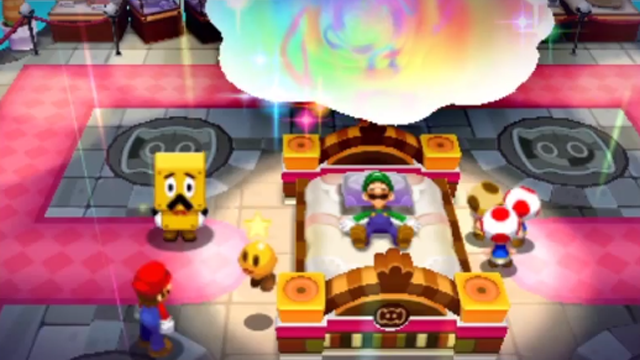
Major aesthetic improvements there. The whole world just feels lush in that trademark Nintendo way. Clearly the artists and writers took the time to smooth out every aspect of the world; Pi’illo Island feels grand, inhabited, and bouncy — there’s nothing quite like hearing that trademark *boing* as Mario and the other guy spring through the world, even if you’ve heard it a million times before.
As you’re walking around the island, you’ll encounter a wide range of enemies — some original to this game, others familiar to anyone who has seen Mario jump. (No Mario game would dare to not feature Goombas or Piranha Plants.) When you run into an enemy, you’ll enter a separate battle screen, JRPG-style, and engage in turn-based combat.
But while combat in most Japanese-style role-playing games is all about preparation — getting to the right level; picking the right equipment — combat in Mario & Luigi: Dream Team tests your dexterity. There are levels and equipment, yes, but instead of just relaxing and watching your characters attack, you have to guide them, pressing buttons and manoeuvring at the right time in what amounts to rudimentary micro-games. These, more than gear or stats, will determine your success.
Hit the A button at the right time during a Mario jump and you’ll do more damage. Hit B when Luigi is shaking his hammer and you’ll see the word “Excellent” appear on the screen. When you’re using special moves — “Bros. Attacks” — the timing is more complex, requiring different combinations and levels of precision depending what you’re trying to do.
Dodging is a similar trial — every enemy will try to attack you in different ways, and part of the fun here is recognising an enemy’s attack patterns, then properly jumping or hammering or sliding to avoid them. As the game gets trickier, so too do the monsters, and many battles will see your plumbers dodging and weaving through all sorts of tricky obstacles.
(If you can’t figure one of these sections out, no worries — lose all your characters’ health points and you’ll be given the option to try again in Easy Mode, which basically makes the Mario brothers invincible for that battle.)
That’s how it works in the real world. In the dream world, you can use what the game calls Luiginary Attacks, which are perhaps the most satisfying element of Mario & Luigi: Dream Team. Mario, no longer content to abuse merely one Luigi, can now summon hundreds of dream-crafted brothers and turn them into weapons for his horrific amusement.
An example:
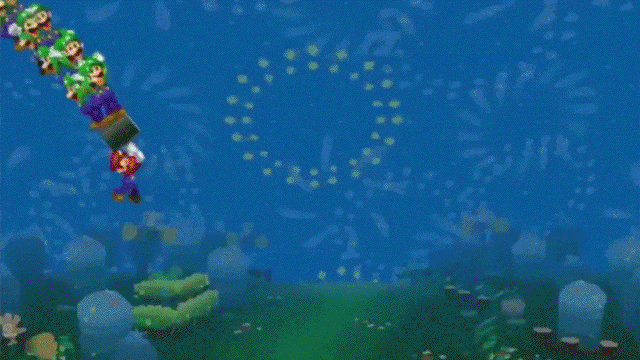
Then there are the giant battles. At certain predetermined points in the game, you’ll have to hold the 3DS vertically and help guide a gargantuan version of Luigi as he fights big monsters and mechanical constructs. This is a bit of gameplay carried over from Bowser’s Inside Story, in which it was innovative and interesting. In Dream Team, these battles are as tired as the plumber who stars in them. Like the summer blockbuster Pacific Rim, they’re more concerned with the spectacle of giant monsters than they are with engaging the audience, and they’re twice as long as they need to be.
But even though you might be tempted to drop your 3DS when it doesn’t recognise a slide move that you’re sure you pulled off correctly, the music, composed by the legendary Yoko Shimomura, makes even the most frustrating giant Luigi battle an enjoyable experience. Even when you’ve entered the dream world some 40 times and you’re really quite sick of fighting random battles, you’ll want to keep playing just to see more of the witty, entertaining, at-times-groan-inducing dialogue from the expert localisation hands of Nintendo’s Treehouse.
See, when you’re not battling, or exploring, you’re probably going to be talking to the random critters that inhabit Pi’illo Island, and Dream Team rewards you for doing so. As is tradition with Mario RPGs, taking your time to talk to people will grant you wordplay and self-aware humour and wonderful little meta discoveries involving beans and costumes. (“A Mush Room? Like, a Porridge Parlor?”) There’s even a little trading quest that calls back to the Game Boy Zelda games.
Sadly, no amount of sharp localisation could fix Mario & Luigi: Dream Team‘s very-Japanese tendency to tell you what to do at every moment — this is a game that, rather than giving you a puzzle and letting you figure out how to solve it, will smack you with the solution nine times out of 10, to the point where many of the game’s dungeons ditch the joy of discovery in favour of the joy of… doing what you’re told. Which can be charming, in a way. When you get used to it. Still, this is no Zelda — even when it wants to be.
Yet Mario & Luigi: Dream Team is a fluffy, perky game, at times simultaneously charming and infuriating. It does so many things so well, from the silly little puns stuffed into every line of dialogue to the welcomely tricky enemy attacks, that I couldn’t help but fall in love with the game, Luigi-sized warts and all.
To contact the author of this post, write to jason@kotaku.com or find him on Twitter at @jasonschreier.
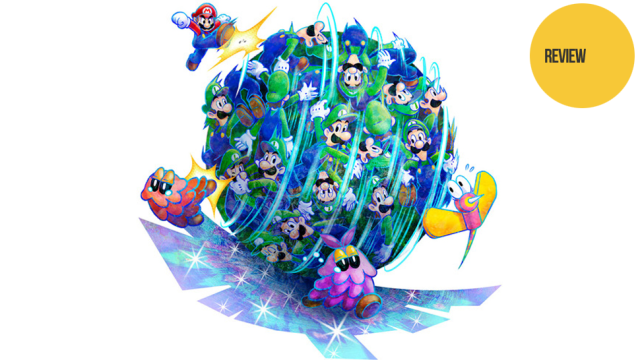
Comments
8 responses to “Mario & Luigi: Dream Team: The Kotaku Review”
Me wantee.
*Mii wantii
absolutely loving this game… the only main annoyance is the constant tutorials but apart from that i’ve put about 7 hours into it so far and loved every minute of it so far
“Mario & Luigi: Dream Team, which comes out August 11 for the 3DS”
Third time i’ve said it ITS BEEN OUT FOR AT LEAST A MONTH IN AUS SO PLEASE EDIT!!!!!!!!!!!!!!! please dont copy and paste from US site or any other without checking ….
I’m glad I’m not the only person thinking this. . .
It’s been a long time coming – can’t wait to get my hands on it!
Another great game for a console that everyone said was bad on release… This is the wiiU in a year or 2
Shit, didn’t think this game was so long! I haven’t bought it yet for some reason, but I’ll try and get it soon!
If you were very disappointed with Paper Mario 3DS like I was, this is a very welcome replacement for it, fights actually mean something and it’s got a similar sense of humor to the paper Mario series.